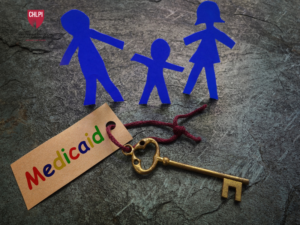Originally written by Clea Simon and published on Harvard Law Today on Sept. 8 2022.
Upcoming White House conference on food and health draws from Harvard Law food strategy blueprint
On Wednesday, Sept. 28, when the White House convenes a conference on food and health for the first time in more than 50 years, it will be tackling sprawling issues of equity, policy, and science. While the initial gathering in 1969 led to major policy innovations, from how we label food to more nutritious school lunches and the creation of the Supplemental Feeding Program for Women Infants and Children, or WIC, new approaches are needed, say experts at Harvard Law School.
[Watch: President Biden announces the White House Conference on Hunger, Nutrition, and Health]
Looking ahead to the White House Conference on Hunger, Nutrition, and Health, Professor Emily M. Broad Leib ’08, who serves as faculty director of the Harvard Law School Food Law and Policy Clinic, and Katie Garfield, a clinical instructor at the Center for Health Law and Policy Innovation, say that drafting a national strategy for food must be a major priority.
“Food is really important,” said Leib. “But there’s no one agency in charge of food. No one leading agency that focuses on how we make sure that food is safe, healthy, sustainable, and available. And that means food is often forgotten.”
The frequent result, Leib explained, is surprisingly contradictory policy: “We have dietary guidelines that make suggestions of what we should be consuming. And then our agricultural subsidies are funding completely different foods,” she pointed out. Another persistent challenge, she said, “is moving from food security to nutrition security, having more of a lens on the healthfulness of food.”
The two argue that the effects of these problems cannot be underestimated. “We know that that nutrition has an incredible impact on health,” said Garfield. “But not having an appropriate diet is the leading risk factor for death in the United States.”
While no nongovernmental bodies are involved in the official planning of the conference, both Harvard Law programs have worked with organizations and coalitions across the country to submit recommendations to conference organizers. They plan to host an event on campus at which Harvard Law students can watch and discuss the White House conference livestream.
As part of their preparations, Harvard Law School clinics have been hosting and participating in listening sessions to encourage community engagement. These have given rise to such recommendations as an increase in the Supplemental Nutrition Assistance Program, or SNAP, benefits to match rising food costs. They also want to expand SNAP, formerly known as “food stamps,” to cover food delivery and to increase online access food and other benefit programs.
In addition, Leib would like to see the creation of a federal grant program to fund food recovery infrastructure in the states, covering such expenses as cold storage and transportation, as well as an updating of the tax laws governing food donations. “During COVID, people had lots of extra food, and they wanted to get it to those in need,” said Leib.
A national strategy, she explained, would coordinate efforts to alleviate such problems while addressing equity issues ranging from food deserts in underprivileged communities to food waste. “We need to have a coordinated vision with priorities so that everyone who is touching the food system can make sure that they’re furthering this plan,” said Leib. Such a strategy would dovetail with the White House conference’s stated goal: “End hunger and increase healthy eating and physical activity by 2030, so that fewer Americans experience diet-related diseases like diabetes, obesity, and hypertension.”
The White House conference won’t be starting from scratch. In 2017, the Harvard Law clinic Broad Leib leads, along with the Vermont Law School Center for Agriculture and Food Systems, released a blueprint for why and how the U.S. should create a national plan, “Blueprint for a National Food Strategy.” They updated this in 2020 with “The Urgent Call for a U.S. National Food Strategy.” In 2019, Canada used the initial report as the framework for its first-ever national plan, pledging $134 million to implement the Food Policy for Canada, which focuses on a “healthier and more sustainable food system.” Among other actions, the policy has funded facilities to reduce food waste and invested in First Nations and indigenous food systems.
The plan’s creation, said Leib, has enabled Canada to set and fund long-term priorities. It also shows what could be achieved south of the border. “We’ve been calling for this here in the United States,” she said. “And COVID has only made this more important.”
Both the pandemic and global disruptions to agriculture and supply chains, Leib and Garfield agreed, have highlighted the need for a new focus on food. For example, nonprofits that provide nutrition interventions (“Food is Medicine” organizations) have seen “a dramatic increase in demand for their services to address both rising food insecurity and also the increased concern about diet-related chronic illness, a big risk factor during COVID,” reported Garfield.
Food production and distribution has also been negatively impacted by the pandemic, noted Leib. As with so many other food and health issues, COVID magnified issues of social inequity. “People working in food production, from farmers to grocery store clerks, have been persistently underpaid and under-protected,” said Leib. But when the pandemic first hit, these same workers “were suddenly considered essential and couldn’t stay home.”
Most recently, the war in Ukraine has greatly increased problems with global food supply, while climate change has simultaneously increased insecurity and spotlighted the pivotal role of agriculture. “Agriculture and food production is a huge contributor to climate change,” said Leib. “But it also can be a mitigator. There’s a lot of potential for sequestering more carbon in soil in managed forests, which are part of the Department of Agriculture, and through farm practices.”
For Garfield, the fact that the White House conference is specifically linking hunger, nutrition, and health already feels like a win. She sees this as fitting with her legal clinic’s “Food is Medicine” portfolio, which studies “the specific connection between nutrition and health.”
Working with local, state, and national nonprofits, “we’re really trying to assist those coalitions and those organizations to make sure that the challenges that they’re facing from a policy perspective are part of the conversation at the White House conference,” said Garfield. Ideally, she said, the gathering will expand the concept of healthcare to include nutrition, which would mean redefining benefits from federal programs like Medicare and Medicaid to include food and nutritional interventions. Such a move, she said, “would make sure that individuals who are living with chronic illness or who are at significant risk for chronic illness have access to the foods they need in order to prevent or treat their condition.”
As they gear up for the conference, both Garfield and Leib are focused on continued advocacy and outreach. “Food and law interact in so many ways that are not really visible to most people,” said Leib. “This conference is an enormous win.”


Health Law & Policy, Commentary
Day One Executive Orders: How Will They Impact Health Care Access? – Health Care in Motion
January 23, 2025